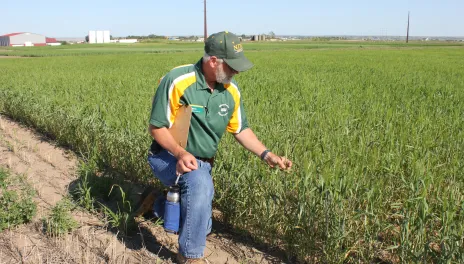48,000 Measurements: Long-term WREC Dryland Research Studies Soil Water Content
Since 2014, Williston Research Extension Center (WREC) soil scientist Jim Staricka, has been measuring the soil water content in 80 field plots every other week from mid-April to the end of October. Measuring at depths of 6, 18, 30, 42 and 54 inches each time, that is 48,000 data points to study and make conclusions from.
At the recent WREC annual field day, Staricka shared his research with the participants.
“This study aims to understand the relationship between water availability and yield on research plots that contain different dryland cropping sequences,” explains Staricka. “Each of the sequences included durum. Other crops included in many of the sequences were pea, safflower, corn, a cover crop, fallow or a perennial mix.”
“Because the MonDak region is water limited, with about 14 inches of precipitation per year, we wanted to understand more about how different crop sequences may have the ability to retain soil water and thus impact yield,” says Staricka.
After studying the measurements, Staricka has made several observations:
- Soil water changes very little at a 5-foot depth, indicating crops obtain a very small amount of water from that depth.
- Since 2014, the plot’s soil moisture was the driest ever on August 12, 2021, and the wettest ever on May 17, 2022, and resulting in going from the driest to wettest in less than one year. During most years, the soil was the driest in July, August or September and was the wettest in April, May or June.
- After measuring the soil water availability following six different crops, Staricka was surprised to find the soil was driest after growing a cover crop. He then realized that the soil was dry because the cover crops were still growing and taking up water long after other crops were harvested and had stopped removing water from the soil. He also then realized it would be better to compare the amount of plant available water in the soil the following spring.
- Cropping treatments that leave tall standing stubble or plant material are much more efficient at catching snow and replenishing soil water during the winter. Staricka found no over-winter increase in soil water occurring after fallow, a moderate increase occurring after pea, durum and safflower, and the greatest increase occurring after the cover crop and the perennial grass, both of which had been left standing unharvested during the winter.
- Durum yields ranged from about 20 bushels per acre to nearly 80. Water use varied from seven to 14 inches. But regardless of whether it was a dry year or a wet year, the relationship between water use and durum yield remained constant. It took four inches of water to get the durum crop to the point where it would produce grain. After that, each additional inch of water produced nearly seven bushels of grain.
“We also are looking at long-term trends in soil organic matter, soil pH and other soil properties,” says Staricka. “Based on these observations, I think we can make some practical recommendations to area farmers about how different management practices can increase their durum yields.”
FOR MORE INFORMATION:
Jim Staricka, 701-774-4315, james.staricka@ndsu.edu

